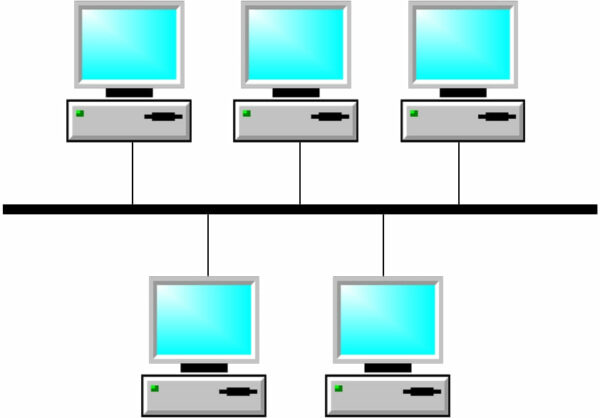Bus Topology: A Brief Overview of Network Architecture
In the world of networking, the choice of network architecture plays a crucial role in determining how devices communicate and exchange information. One such architecture that has stood the test of time is bus topology.
This article delves into the ins and outs of bus topology, providing a comprehensive understanding of its functioning, pros, cons, and practical implementations.
Table of Contents
Bus Topology: A Brief Overview of Network Architecture

Bus topology is a fundamental network arrangement where all devices in a network are connected to a single central cable called the bus. This cable serves as the communication pathway, transmitting data between devices. Despite its simplicity, bus topology has found applications in various scenarios due to its ease of setup and cost-effectiveness.
Advantages of Bus Topology
Bus topology offers several benefits that make it a viable choice for certain network setups:
- Simplicity: The straightforward design of bus topology makes it easy to implement, even for non-technical users.
- Cost-Effective: Bus topology requires minimal cabling, reducing the overall cost of network setup.
- Efficient for Small Networks: In small networks, the performance of bus topology remains efficient and effective.
- Easy Expansion: Adding new devices to the network involves connecting them to the central cable, simplifying expansion.
- Passive Topology: The passive nature of bus topology ensures that the failure of one device doesn’t affect the entire network.
Disadvantages of Bus Topology
While bus topology has its merits, it also comes with certain limitations:
- Limited Scalability: As the network grows, the efficiency of bus topology decreases, leading to potential performance issues.
- Single Point of Failure: The central cable acts as a single point of failure; if it breaks, the entire network is disrupted.
- Performance Degradation: With more devices connected, the data transmission speed can degrade, causing slower communication.
- Difficult Fault Detection: Identifying faults or damaged devices within the network can be challenging without specialized tools.
- Network Congestion: Increased traffic can lead to congestion, affecting the overall network performance.
Real-World Applications of Bus Topology
Bus topology, despite its limitations, finds practical use in specific scenarios:
- Small Offices: In small office setups with limited devices, bus topology’s simplicity and cost-effectiveness make it a suitable choice.
- Computer Labs: Educational institutions often use bus topology in computer labs, where the number of devices is manageable.
- Point of Sale (POS) Systems: Bus topology can be seen in POS systems where multiple devices like cash registers and card readers are connected.
- Home Networks: For basic home networks with minimal devices, bus topology remains an uncomplicated solution.
Implementing Bus Topology: Step-by-Step
Setting up a bus topology network involves the following steps:
- Gather Equipment: Collect the necessary cables, terminators, and devices you plan to connect.
- Identify the Central Cable: Choose a central cable through which all devices will connect.
- Connect Devices: Attach each device to the central cable using appropriate connectors.
- Termination: Place terminators at both ends of the central cable to prevent signal reflection.
- Testing: Power on the devices and test communication to ensure proper connectivity.
FAQs (Frequently Asked Questions)
How does bus topology work?
Bus topology connects devices to a central cable, allowing data transmission and reception through the same cable.
Can I add new devices easily to a bus topology network?
Yes, adding new devices involves connecting them to the central cable, simplifying the process.
What happens if the central cable in a bus topology network gets damaged?
If the central cable breaks, the entire network loses connectivity until the cable is repaired.
Is bus topology suitable for large networks?
Bus topology’s efficiency decreases in larger networks, making it less suitable for extensive setups.
How do terminators prevent signal reflection?
Terminators absorb signals at the ends of the central cable, preventing reflections that could disrupt communication.
Are there alternatives to bus topology?
Yes, alternatives include star topology, ring topology, and mesh topology, each with its own advantages and disadvantages.
Conclusion
In the realm of network architecture, bus topology stands as a testament to the power of simplicity and cost-effectiveness. While not without its limitations, its application in specific scenarios showcases its practicality. Understanding the fundamentals of bus topology empowers network administrators and enthusiasts to make informed decisions about their network setups.
Related posts:
- Ring Topology Overview: Exploring the Circular Network Design
- Star Topology: Understanding the Centralized Network Design
- Network Topology | Exploring Efficient Network Structures
- Home Network Architecture Explained: A Guide
- Exploring Home Network Topologies
- Wi-Fi Standards: A Comprehensive Overview
About Dirk
Hello, I'm Dirk! I had my first contact with computers during my training as an electronics technician. At that time, I was still working on PLC programming, but computers have never let me go. Later, I studied IT business administration and started this blog. After a very long break, I'm also back on social media. Currently only on Twitter, Xing and LinkedIn but other social networks may follow.


